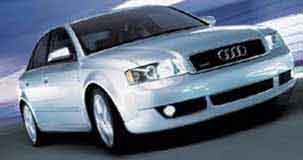

|
ECU Fault Code Retrieval 1984-85 5000 Turbo with KH engine
Introduction: Engine Control Unit (ECU) Fault Code System The 1984-85 Audi 5 cylinder Turbo engines have Engine Control Units equipped with a "self-diagnostic system". This system can test 10 input system items. Anytime an engine problem is occurring, this Fault Code system should be used to first locate any system fault codes that have been recorded. The ECU memory constantly monitors the operation of the engine and automatically stores any faults or defects found [5]. This diagnostic information can be retrieved by manually operating the throttle switches and brake light switch in a specific sequence. The fault code error code information is displayed by the tachometer needle position and by the operation of the Check Engine light. The "Idle" and "Full" Throttle switches should be checked first before attempting to perform the diagnostics. Using the following diagrams, test the resistance of the idle and full throttle switch with the engine turned off . Diagram courtesy of Audi of America Diagram courtesy of Audi of America Use a Digital Volt/Ohm meter to measure the resistance across the idle and common terminal with the throttle closed, the resistance should be less than 1 ohms. With the throttle open, the resistance across the idle and common terminal should be infinity (very high). Then measure the resistance across the full throttle terminal and the common terminal with the throttle fully open,the resistance should measure less than 1 ohm. The resistance across the full throttle contact and common should be infinity (very high) with the throttle closed. The brake light switch must be operating correctly as well. The brake lights must come on with the brake depressed and the ignition turned on. The brake light must also be turned off when the brake pedal is released. This system uses the "Check Engine" light in the instrument cluster to indicate faults in the system when the vehicle is driven. This light must illuminate whenever the ignition is turned on with the engine not running. Diagrams courtesy of Audi of America If this "check engine" light does not illuminate when the ignition is turned on, check the wiring according to the wiring diagram and check the light bulb in the instrument panel. The light will come on if continued engine knocking occurs. This indicates that the driver should reduce the amount the accelerator is pushed down to reduce the engine load so the knocking will cease. This could be due to poor fuel quality, i.e. low octane fuel or by excessive boost pressure, or carbon build up in the combustion chamber. Other abnormal engine noises may also cause the knock sensing system to react and turn on this light. The light will also come on if a fault occurs in the system (Certain signal inputs to the control unit are faulty or missing). This will usually occur only above 3000 RPM because certain conditions must be met by the ECU to test these signal inputs to the ECU. The Check Engine light will stay on as long as the engine RPM is above 3000 and the fault occurs in the input signal to the ECU [5] The Light is used together with the tachometer for displaying error codes during the diagnosis procedure. If the vehicle starts: You should drive the car for a minimum of 5-10 minutes and raise the engine speed above 3000 RPM and ensure that the manifold pressure goes above 1.2 bar. You want the engine coolant temp to get above 80C, (176F). You should accelerate at full throttle in 3rd gear to exercise this diagnostic system correctly. If the vehicle does not start: Crank the engine with the starter for at least 5 seconds. NOTE: On the 1984-85 5000 Turbo the ignition should NOT be turned off after doing this full throttle test road test or after the "No Start" cranking test is done, as the fault memory will be erased. After doing the road test or the "No Start" cranking test, proceed to the section below for reading any fault codes stored during this process. Fault Code Reading: 1984-85 5000 Turbo As mentioned, this system uses the "Check Engine" light in the instrument cluster and the Tachometer needle position to indicate faults in the system during the fault code reading process. [6] To start the fault code reading sequence with the engine running after a road test or with the ignition on after cranking the engine, open the hood and locate the full throttle switch. Manually close the full throttle switch for at least 3 seconds and then release. The tachometer should now read 7000 RPM. This diagram shows the procedure to start the fault code retrieval process. Diagram courtesy of Audi of America Stored faults will be displayed in a sequence or in steps. To move to the next step in the diagnostic sequence, push the brake pedal once while observing the tachometer needle location and the Check Engine light. The sequence will not repeat, so if a fault is found, you should write it down and retest the system after performing the repair.
Diagram courtesy of Audi of America The recommended check or repair is located below, after the diagnostic procedure description. Check the Bentley Manual [6] for additional component trouble-shooting
information. Diagram courtesy of Audi of America References: [5] Audi of America Technical Service Training Booklet "1985 Model Change Information" [6] Audi 5000 Factory Repair Manual 1984-88 Robert Bentley, Inc. Copyright © SJM Autotechnik™ , all rights reserved Return to Troubleshooting Tips page. Return to SJM Autotechnik™ main page. |
| About Us Privacy Policy Terms of Use Links Customer Service Safety Information Home |